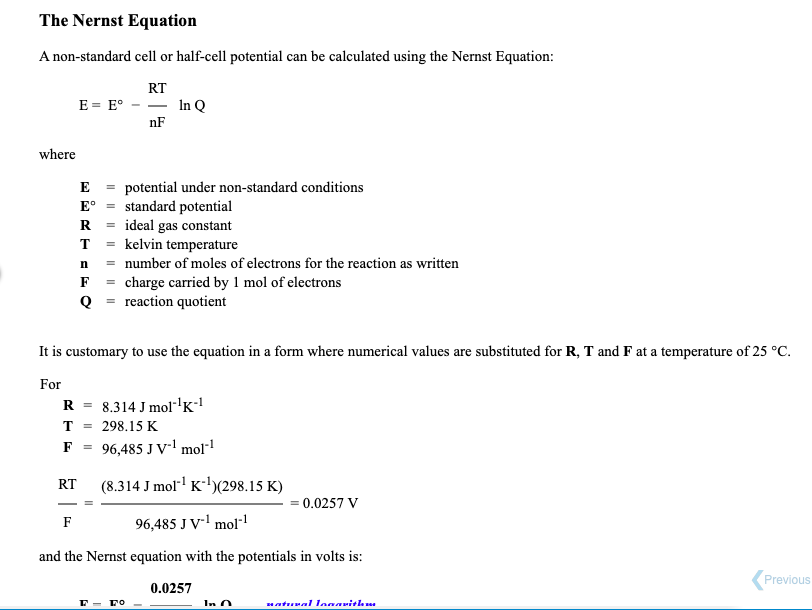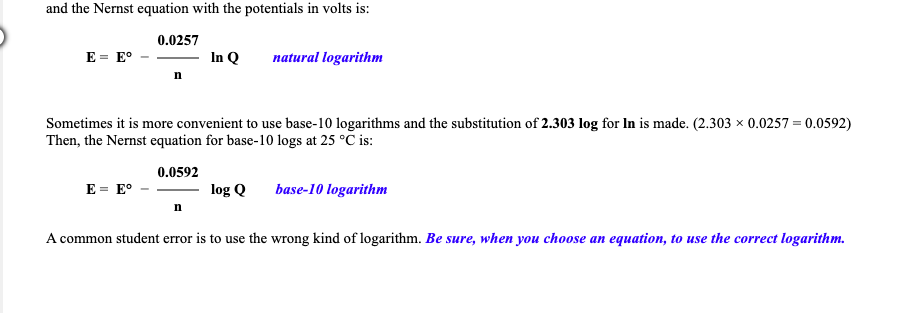What is the calculated value of the cell potential at 298K for an electrochemical cell with the following reaction, when the Hg2+ concentration is 3.59×10-4 M and the Cr3+ concentration is 1.07 M ? 3Hg2+(aq) + 2Cr(s) →3Hg(l) + 2Cr3+(aq) Answer: ____ V The cell reaction as written above is spontaneous for the concentrations given: _______ (true or false)
What is the calculated value of the cell potential at 298K for an electrochemical cell with the following reaction, when the Hg2+ concentration is 3.59×10-4 M and the Cr3+ concentration is 1.07 M ? 3Hg2+(aq) + 2Cr(s) →3Hg(l) + 2Cr3+(aq) Answer: ____ V The cell reaction as written above is spontaneous for the concentrations given: _______ (true or false)
Chemistry by OpenStax (2015-05-04)
1st Edition
ISBN:9781938168390
Author:Klaus Theopold, Richard H Langley, Paul Flowers, William R. Robinson, Mark Blaser
Publisher:Klaus Theopold, Richard H Langley, Paul Flowers, William R. Robinson, Mark Blaser
Chapter17: Electrochemistry
Section: Chapter Questions
Problem 31E: Determine the standard cell potential and the cell potential under the stated conditions for the...
Related questions
Question
100%
What is the calculated value of the cell potential at 298K for an
3Hg2+(aq) + 2Cr(s) →3Hg(l) + 2Cr3+(aq)
Answer: ____ V
The cell reaction as written above is spontaneous for the concentrations given: _______ (true or false)

Transcribed Image Text:The Nernst Equation
A non-standard cell or half-cell potential can be calculated using the Nernst Equation:
RT
E = E° - .
In Q
nF
where
E = potential under non-standard conditions
standard potential
= ideal gas constant
T = kelvin temperature
n = number of moles of electrons for the reaction as written
F = charge carried by 1 mol of electrons
Q = reaction quotient
E°
R
It is customary to use the equation in a form where numerical values are substituted for R, T and F at a temperature of 25 °C.
For
R = 8.314 J mol'K!
T = 298.15 K
96,485 J V-l mol"
F =
(8.314 J mol! K(298.15 K)
RT
= 0.0257 V
F
96,485 J V-' mol-1
and the Nernst equation with the potentials in volts is:
Previous
0.0257
In 0
Hatural lagarithn.

Transcribed Image Text:and the Nernst equation with the potentials in volts is:
0.0257
E = E°
In Q
natural logarithm
Sometimes it is more convenient to use base-10 logarithms and the substitution of 2.303 log for In is made. (2.303 x 0.0257 = 0.0592)
Then, the Nernst equation for base-10 logs at 25 °C is:
0.0592
E = E°
log Q
base-10 logarithm
n
A common student error is to use the wrong kind of logarithm. Be sure, when you choose an equation, to use the correct logarithm.
Expert Solution
This question has been solved!
Explore an expertly crafted, step-by-step solution for a thorough understanding of key concepts.
This is a popular solution!
Trending now
This is a popular solution!
Step by step
Solved in 3 steps

Knowledge Booster
Learn more about
Need a deep-dive on the concept behind this application? Look no further. Learn more about this topic, chemistry and related others by exploring similar questions and additional content below.Recommended textbooks for you

Chemistry by OpenStax (2015-05-04)
Chemistry
ISBN:
9781938168390
Author:
Klaus Theopold, Richard H Langley, Paul Flowers, William R. Robinson, Mark Blaser
Publisher:
OpenStax

Chemistry: Matter and Change
Chemistry
ISBN:
9780078746376
Author:
Dinah Zike, Laurel Dingrando, Nicholas Hainen, Cheryl Wistrom
Publisher:
Glencoe/McGraw-Hill School Pub Co

Chemical Principles in the Laboratory
Chemistry
ISBN:
9781305264434
Author:
Emil Slowinski, Wayne C. Wolsey, Robert Rossi
Publisher:
Brooks Cole

Chemistry by OpenStax (2015-05-04)
Chemistry
ISBN:
9781938168390
Author:
Klaus Theopold, Richard H Langley, Paul Flowers, William R. Robinson, Mark Blaser
Publisher:
OpenStax

Chemistry: Matter and Change
Chemistry
ISBN:
9780078746376
Author:
Dinah Zike, Laurel Dingrando, Nicholas Hainen, Cheryl Wistrom
Publisher:
Glencoe/McGraw-Hill School Pub Co

Chemical Principles in the Laboratory
Chemistry
ISBN:
9781305264434
Author:
Emil Slowinski, Wayne C. Wolsey, Robert Rossi
Publisher:
Brooks Cole

Principles of Modern Chemistry
Chemistry
ISBN:
9781305079113
Author:
David W. Oxtoby, H. Pat Gillis, Laurie J. Butler
Publisher:
Cengage Learning

Chemistry: An Atoms First Approach
Chemistry
ISBN:
9781305079243
Author:
Steven S. Zumdahl, Susan A. Zumdahl
Publisher:
Cengage Learning
